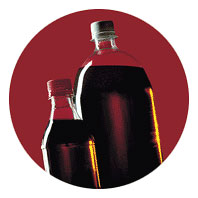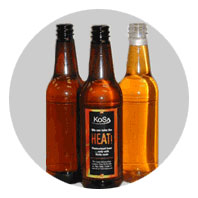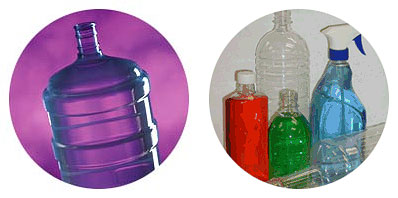The fact that PET is used for such a variety of packaging items ? from soft drinks to cosmetics ?demonstrates how the qualities of the resin must match the standards needed to keep the product preserved and safe for travel. Not only does the product need to be maintained in good condition, but it also needs to sell. For that reason, the drink or food item and its packaging must be attractive, sensible and convenient. The resin chosen for a certain PET application has to fulfil the requirements of the end product. Strength, clarity, barrier performance and UV resistance are only a few of the factors to be considered in packaging.
Homopolymers and copolymers are both used in PET resins. A homopolymer is PET containing only ethylene glycol and terephthalic acid repeat units which results in the highest melt point and the best strength properties possible. A copolymer is PET containing additional monomers, such as isophthalic acid, to disrupt the polymer chains, resulting in a lower melting point, slower crystallisation and improved clarity particularly in heavy wall applications.
 |
Different grades of resins are appropriate for different end uses. Their specific qualities make them ideal for the product which they have been designed to package. What qualities of PET are important? As mentioned above, the qualities that are important depend very much on the product for which the bottles is destined: CSD -- Carbonated Soft Drinks Strength: The resins in PET bottles used to package carbonated soft drinks need very specific qualities. The material must be extremely strong to contain the internal pressures of CO2 without distortion or expansion. This is obtained by using a resin which has high IV and lower copolymer levels. Clarity: Clarity is an important aspect of drink packaging in terms of consumer acceptance. A low level of crystallisation is needed to achieve clarity. Colour: Although one of the key qualities of PET is that it can be used as a perfectly clear material, with soft drinks this property is not |
| essential as many soft drinks themselves are coloured, while clear soft drinks are packaged in coloured PET bottles. Water -- The Clear Story Some waters are packaged in exactly the same bottles as carbonated soft drinks and would therefore carry many of the same requirements, but some vary. Strength: Unlike carbonated drinks, the bottle filled with still water needs only enough strength to hold water and to survive impact. IV requirement is reduced to the .74 to .76 range in most cases. Colour and Clarity: Clarity is one of the most important reasons why PET is used for packaging water. PET used in water bottles needs to be very clear and maybe even slightly blue in colour. A resin with higher levels of copolymer adds to the clarity. |
 |
Juice -- Hot Fill Qualities
Juices and many other products such as sport drinks or other high acid drinks are hot filled into PET bottles. In these cases the package is heat set in order to improve the temperature resistance of the container. PET resins with a higher Tg (glass transition) temperature and/or a faster rate of crystallisation are preferred. Generally lower levels of copolymer are preferred and IVa€?s of about .80 are acceptable.
Strength and colour/clarity: This factor is not as important with juices as CSD’s or water. The purity factor is important, as juices would contract the taste of the plastic bottle if not pure enough.
Beer -- A New Market with New Requirements
Beer is often seen as an extension of the CSD market, but also often requires heat fill and barrier qualities. Because the technologies used to make beer bottles are varied and the applications differ (cold filled or pasteurised), finding a common denominator is difficult. Making a bottle to meet the desired requirements has been the most important factor. The types of PET beer bottles typically used are: non-tunnel pasteurised, one way tunnel pasteurised and returnable/refillable bottles.
 |
Barrier: Beer needs higher performance in both CO2 and O2 barriers compared to PET used in CSD applications. The level required depends on the type of beer, container size, distribution channels and environmental conditions (storage time, temperature and humidity levels). Improvements in barrier properties can be obtained via coatings, creating mutli-layer bottles and scavengers. Colour, clarity and UV protection: Beyond the barrier properties, most beers also need to be protected from UV light. Protection can be obtained |
Strength: Beer bottles do need strength in order to maintain the CO2 pressure over a wide range of temperatures including pasteurisation. IVa€?s in the .80 to .84 range are normally favoured. Beer bottles also tend to use champagne bases rather than footed or a€?petaloid bases. In all of the above cases, the resource efficiency of PET - due to its light weight - is one of the essential reasons why it is used with these consumer drink products. Not only does the consumer benefit, but the transportation costs and energy consumption in delivery are decreased due to its weight. Because PET bottles are so much lighter than alternatives, a truck can carry 60% more of the beverage and 80% less packaging ?a fuel saving of 40% and less air pollution.